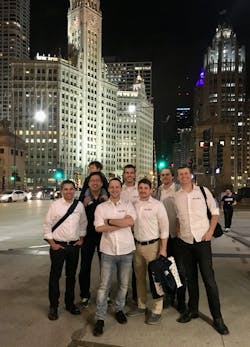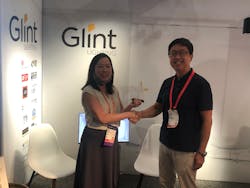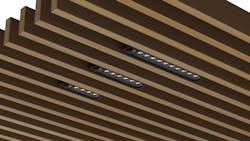Burlingame, Calif.–based Glint Lighting was recently recognized in the 2022 LEDs Magazine BrightStar Awards program for innovative updates to its previous Sapphire Award-winning Hero recessed luminaire. Founded in 2012 as Glint Photonics, the Silicon Valley business launched with a focus on optical systems research, which led to the development of solid-state lighting products as Glint Lighting in 2016.
CEO Peter Kozodoy and COO Andrew Kim lead a collaborative, tightknit team of engineering professionals whose educational pedigrees hail from both U.S. coasts, representing Yale University, University of Pennsylvania, Massachusetts Institute of Technology, University of California Santa Barbara, UC Berkeley, UC Davis, and California Institute of Technology.
Glint executives shared the road that led their company to specialty and commercialized SSL products and industry and media recognition of their optical expertise.
Firm mission: At Glint, our mission is to help you beautifully illuminate spaces for improved wellbeing, while consuming a minimum of space and resources. Our products virtually disappear into the architecture to provide exceptional light utilization and visual comfort without drawing undue attention to themselves.
What we are known for: Hero with LightShift and PureBeam delivers two profound innovations. LightShift makes Hero the world’s first luminaire whose beam direction can be adjusted without moving the light fixture, enabling harmonious architectural integration and profound visual comfort. PureBeam gives Hero beautiful beam quality and uniformity that is consistent at every beam angle and throw. A tremendous amount of optical, mechanical, and materials research made this possible, but we really focused on crafting a revolutionarily simple product. And what could be simpler than a luminaire you can put where you want it, place its light where you need it, and deliver the same perfect beam at every angle and throw?
What people don’t know about us: Glint is a Silicon Valley startup company that is tight-knit. We work and celebrate together. Our kids know each other and their uncles and aunts on the staff. In our first big commercial order, everyone worked on the line, spouses lent a hand, and a neighbor baked us “Glint Lighting” loaves of bread.
First commission: In 2019, we brought Hero to the Peninsula Museum of Art, in San Bruno, Calif., for an installation commissioned by San Francisco–based lighting designer Larry French. Experiencing how Hero’s harmonious architectural integration and exceptional beam quality transformed a real space was incredibly rewarding.
The CBS series California by Design featured us in its 2020 season. True design celebrities and a film crew visited us at Glint headquarters, and we documented the commissioning of the gallery from start to finish — no pressure! The series was run as a design and innovation competition, and the 33 mind-boggling products featured included a hydrofoil board and interplanetary lander, a smart speaker and 3D AI, and a home gym and smart playground. We were stunned and honored to win third place overall at the series finale!
What are you currently working on? We are expanding technical and style options for Hero to meet customer needs, while also preparing an entirely new product line of adjustable luminaires for this year’s Light + Building trade show. Next year will bring another category-defying class of luminaires and our first forays into general lighting. The common theme is harmonious architectural integration with superb photometrics and visual comfort.
Favorite lighting/engineering rule of thumb, standard, or equation: Deep technical innovation to deliver revolutionary simplicity.
Industry generalization or perception that should be debunked: The solid-state lighting revolution can seem primarily about LEDs. The introduction of illumination-grade LEDs was a seismic event in the lighting industry: You could drop them into a luminaire and improve efficacy and lifetime by an order of magnitude. It made sense that the resources and the rocket scientists went to LEDs. But we believe the second solid-state revolution will be about the systems you can build around LEDs — and the industry only has begun to scratch the surface of the potential. Glint is the result of applying world-class materials and electrical, mechanical, and optical engineers more often associated with LED companies to producing innovative luminaires.
Top industry concern today: Light utilization, light trespass, and glare. Light in the wrong place is not only wasted energy, but it also creates real physiological harm. Mitigating it can be costly in materials and space.
Lighting aggravation (one thing you can’t stand seeing on paper or built): A defective luminaire is a tragedy; with LEDs, they should be as rare as Halley’s Comet. The energy an LED luminaire consumes over its lifetime should be about the same as the energy consumed to make the luminaire. Shoddy luminaires made with low yields and truncated lifetimes short-change the sustainability promise of solid-state lighting.
What should the lighting industry talk more about? What does it mean for a light fixture to disappear into the architecture? One approach is to hide the fixture, but does it disappear or simply create additional architecture? A deeply recessed downlight requires a deep plenum and yet still leaves a black hole. A cove light requires the building of a cove. In our product definition process, we are more interested in how a light fixture becomes a harmoniously integrated part of the built environment and less about hiding — how to achieve camouflage with stillness more than with disguise.
Lighting aspect you want to learn more about: Many of us are fascinated by the innovation in midcentury lighting, where interplay of new photometrics, materials, and design resulted in several iconic products. We were delighted with a similar interplay developing Hero — we took an innovative photometric concept, incorporated the fantastically antireflective materials structure of the moth eye to tame glare, and crafted a beautiful design with our partners at Whipsaw Design, resulting in a product with deep integrity as both a light source and an architectural element.
WANDA LAU is editorial director of LEDs Magazine and Smart Buildings Technology. She previously served as executive editor of Architect magazine and worked for a decade in the architecture, engineering, and construction industry.
For up-to-the-minute LED and SSL updates, follow us on Twitter. You’ll find curated content and commentary, as well as information on industry events, webcasts, and surveys on our LinkedIn page and our Facebook page.

Wanda Lau | Editorial director, LEDs Magazine, Architectural SSL, and Smart Buildings Technology
Wanda Lau is an award-winning editor, writer, and podcaster whose work appears in several publications, including Architectural Lighting and Architect, where she was most recently the executive editor. In 2021, she was named one of Folio: and AdMonsters' Top Women in Media, in the DEI Champions category. Along with working a decade in the architecture, engineering, and construction industry, she holds a B.S. in civil engineering from Michigan State University, an S.M. in building technology from MIT, and an M.A. in journalism from Syracuse University.












